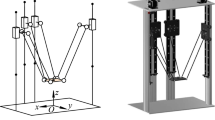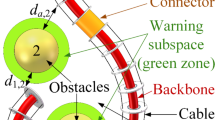Abstract
Because of lots of advantages such as a large workspace, high dynamics and high payload capacity, CDPRs have been widely used in various applications. In this study, kinematics and dynamics of CDPRs was derived for considering dynamic characteristics of CDPRs. This research considered two effective excitation frequencies which are the vibration induced by frame structural characteristics and acceleration profiles. Also, two main frequencies were considered as the variable constraints. They are the fundamental frequencies of each cable and the whole system. By considering them, the wrench-feasible workspace was determined and analyzed at conditions of various accelerations. In comparing the fixed and the frequency-based variable constraints, the size of the workspace was decreased slightly. However, the frequency-based variable constraint method raised stiffness of cables and end-effector. The stability of cables and end-effector was raised. Especially, the stability of cables was highly improved. Finally, the variable constraints method was verified with experiments. This method leads to high stability system.
Similar content being viewed by others
References
B. Kehoe, G. Kahn, J. Mahler, J. Kim, A. Lee, K. Nakagawa, S. Patil, W. Douglas Boyd, P. Abbeel and K. Goldberg, Autonomous multilateral debridement with the raven surgical robot, 2014 IEEE International Conference on Robotics and Automation (ICRA) (2014) 1432–1439.
E. Kljuno and R. L. Williams II, Vehicle simulation system: Controls and virtual-reality-based dynamics simulation, Journal of Intelligent and Robotic Systems, 52 (2008) 79–99.
J. Lamaury, M. Gouttefarde, A. Chemori and P. E. Hervé, Dual-space adaptive control of redundantly actuated cabledriven parallel robots, 2013 IEEE/RSJ International Conference on Intelligent Robots and Systems (2013) 4879–4886.
P. Bosscher, R. L. Williams, L. S. Bryson and D. Castro-Lacouture, Cable-suspended robotic contour crafting system, Automation in Construction, 17 (4) (2007) 45–55.
R. L. Williams, M. Xin and P. Bosscher, Contour-craftingcartesian-cable robot system concepts: Workspace and stiffness comparisons, ASME 2008 International Design Engineering Technical Conferences and Computers and Information in Engineering Conference American Society of Mechanical Engineers (2008) 31–38.
M. Filipović, The importance of modelling an aerial robotic camera, Scientific Technical Review, 62 (1) (2012) 28–37.
J. P. Merlet and D. Daney, A portable, modular parallel wire crane for rescue operations, 2010 IEEE International Conference on Robotics and Automation (ICRA) (2010) 2834–2839.
X. Diao and O. Ma, Vibration analysis of cable-driven parallel manipulators, Multibody System Dynamics, 21 (4) (2009) 347–360.
H. D. Do and K. S. Park, Analysis of effective vibration frequency of cable-driven parallel robot using mode tracking and quasi-static method, Microsystem Technologies, 23 (2017) 2577–2585.
J. Liu, K. J. Ning and M. Y. Zhao, Model of a new type wire driven parallel robot system, Journal-Northeastern University Natural Science, 23 (2002) 991–994.
M. Gouttefarde and J. P. Merlet, Daney, Wrench-feasible workspace of parallel cable-driven mechanisms, Proceedings 2007 IEEE International Conference on Robotics and Automation (2007) 1492–1497.
C. Tavolieri, J. P. Merlet and M. Ceccarelli, A workspace analysis of a overconstrained cable-based parallel manipulator by using interval analysis, MUSME (2008).
A. Z. Loloei, M. M. Aref and H. D. Taghirad, Wrench feasible workspace analysis of cable-driven parallel manipulators using LMI approach, 2009 IEEE/ASME International Conference on Advanced Intelligent Mechatronics (2009) 1034–1039.
J. M. Heo, S. H. Choi and K. S. Park, Workspace analysis of a 6-DOF cable-driven parallel robot considering pulley bearing friction under ultra-high acceleration, Microsystem Technologies, 23 (7) (2017) 2615–2627.
P. Bosscher, A. T. Riechel and I. Ebert-Uphoff, Wrenchfeasible workspace generation for cable-driven robots, IEEE Transactions on Robotics, 22 (5) (2006) 890–902.
X. Tang, L. Tang, J. Wang and D. Sun, Workspace quality analysis and application for a completely restrained 3-Dof planar cable-driven parallel manipulator, Journal of Mechanical Science and Technology, 27 (8) (2013) 2391–2399.
H. Wei, Y. Qiu and J. Yang, An approach to evaluate stability for cable-based parallel camera robots with hybrid tension-stiffness properties, International Journal of Advanced Robotic Systems, 12 (12) (2015).
J. C. Weis, B. Ernst and K. H. Wehking, Use of high strength fibre ropes in multi-rope kinematic robot systems, Cable-Driven Parallel Robots, 12 (2013) 185–199.
J. Nocedal and S. J. Wright, Numerical optimization, Second Ed., Springer, New York, USA (2006) 529–562.
S. S. Rao and F. F. Yap, Mechanical vibrations, New York: Addison-Wesley, 4 (1995).
H. Jamshidifar, A. Khajepour, B. Fidan and M. Rushton, Kinematically-constrained redundant cable-driven parallel robots: Modeling, redundancy analysis, and stiffness optimization, IEEE/ASME Transactions on Mechatronics, 22 (2) (2017) 921–930.
D. Surdilovic, J. Radojicic and J. Krüger, Geometric stiffness analysis of wire robots: A mechanical approach, Cable-Driven Parallel Robots, 12 (2013) 389–404.
Author information
Authors and Affiliations
Corresponding author
Additional information
Recommended by Associate Editor Hugo Rodrigue
Jun-Mu Heo is majoring in mechanical engineering at Gachon university. He is studying for master’s degree. Especially he is specialized at Control and vibration.
Rights and permissions
About this article
Cite this article
Heo, JM., Park, BJ., Park, JO. et al. Workspace and stability analysis of a 6-DOF cable-driven parallel robot using frequency-based variable constraints. J Mech Sci Technol 32, 1345–1356 (2018). https://doi.org/10.1007/s12206-018-0238-1
Received:
Revised:
Accepted:
Published:
Issue Date:
DOI: https://doi.org/10.1007/s12206-018-0238-1




